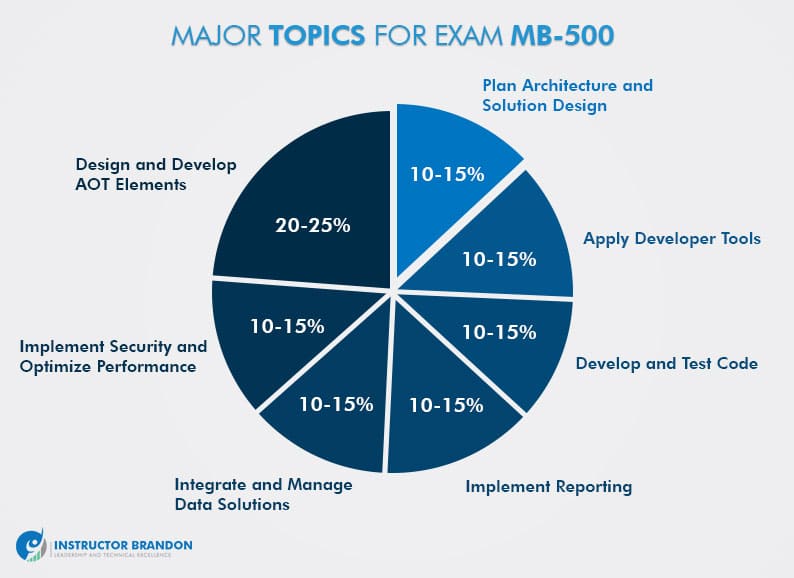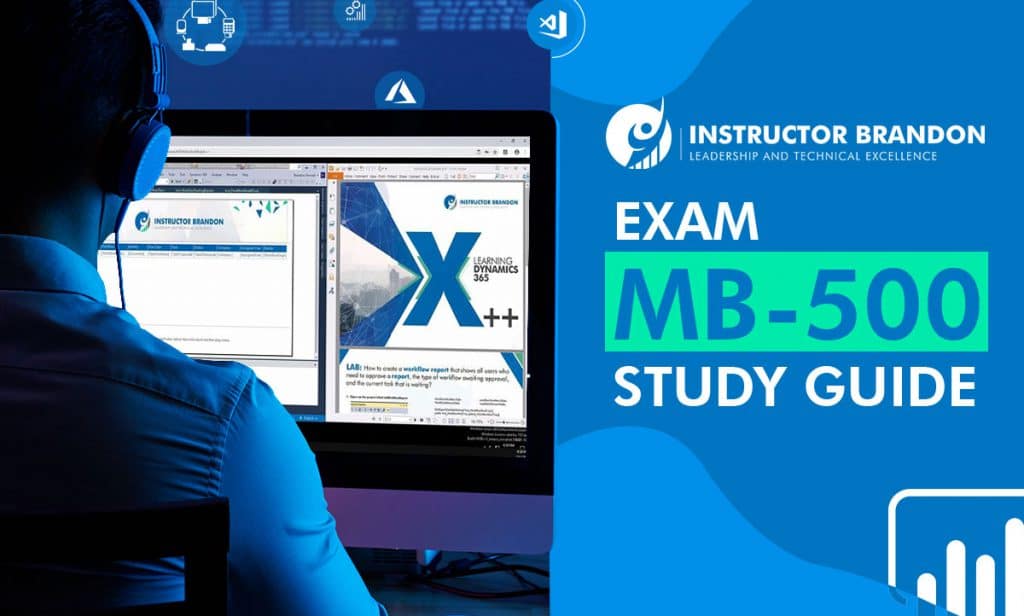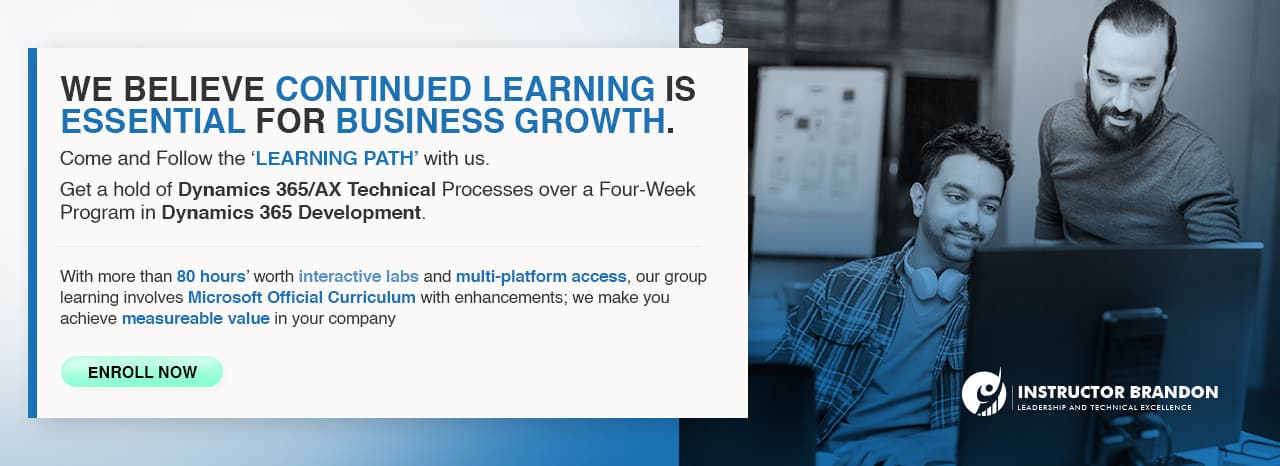Exam MB-500
Exam MB-500 Instructor Brandon Study Guide: Microsoft Dynamics 365: Finance and Supply Chain Apps Developer
The exam MB-500 is pretty highly requested, and it’s one of the very popular Microsoft exams for Dynamics 365 (F&S). There are a lot of common questions about what the exam covers and what it doesn’t cover. So this study guide covers important things related to the exam MB-500 like going over the major topics that are a part of it to go ahead and make sure that you get a pretty good understanding. I hope you all sincerely like our innovative content. And as always, don’t hesitate to reach out to me.. I’m always here to help. — Brandon Ahmad
This is the first of two blog posts discussing the sought-after Dynamics 365 Finance and Operations Apps Developer Associate skill set, as defined by the Microsoft Certified: Dynamics 365: Finance and Operations Apps Developer Associate certification. (Note, at publishing time Microsoft 365 is transitioning from “Finance and Operations” to “Finance and Supply Chain”). Please click on the associated links and follow them as we’ve included a lot of information, which will be helpful as you study for this exam. For those of you wanting a faster and easier way to learn, our official Microsoft courses include full hands on labs, video on demand, lots of extra value added content to really drill into the concepts, and interaction with the instructor. You can see them here.
How to use this Exam MB-500 Study Guide
This exam MB-500 study guide shares information and material useful in preparing for exam MB-500. The relevant modules of our instructor-led Course MB500T00 are mentioned along with the major topics of the exam MB-500 to offer more convenient guidance. This exam MB-500 study guide also includes numerous clickable links that give you detailed information about different fundamental concepts.
Skills to be tested in MB-500 Exam
In preparing for the MB-500 Exam, developers need to have developed a strong command over the major setup and tailoring components of Microsoft Dynamics Finance and Operations. Remember, these skills are not merely theoretical; hands-on practice on actual labs is also important. For that, you can have a look at our instructor-led training course MB-500T00 Microsoft Dynamics 365 Finance and Supply Chain Apps Developer. Our course includes 40% additional course content for a better understanding of this content, with our custom-designed labs for extensive practice.
Here are the 7 major topics covered by the MB-500 Exam weighted by their percentage of the overall exam content. (Note, the exam is not restricted to these topics).
- Plan Architecture and Solution Design (10-15%)
- Apply Developer Tools (10-15%)
- Design and Develop AOT Elements (20-25%)
- Develop and Test Code (10-15%)
- Implement Reporting (10-15%)
- Integrate and Manage Data Solutions (10-15%)
- Implement Security and Optimize Performance (10-15%)

Now we will discuss each of these major topics in detail.
1. Plan Architecture and Solution Design (10-15%)
The following are the three most important topics in this section of the exam that must be learned.
- Identify the major components of Dynamics 365 Finance and Operation
- Design and implement a user interface
- Implement Application Lifecycle Management (ALM)
These three important topics are covered in our course MB-500T00 in the first three modules: Module 00: Overview and Architecture, Module 01: Development Tools, and Module 02: Solution Design. All these modules have additional content and additional lab exercises.
These modules help you learn how to select application components and architecture based on business components and teach how to identify architectural differences between the cloud and on-premises versions of Dynamics FO. Students will prepare and deploy the deployment package in Visual Studio in the lab provided with Module 00: Overview and Architecture.
It’s also important to learn to identify components of the application stack and how to map them to the standard models. For this, there is a lab in Module 02: Solution Design in which students create a model. Students will differentiate the purposes of and interrelationships between packages, projects, models, and elements.
2. Apply Developer Tools (10-15%)
This section of the exam also has three important topics that need hands-on learning for a strong grasp of this content, which comprises 10 to 15 % of the exam.
- Customize Dynamics 365 FO by using Visual Studio
- Manage source code and artifacts by using version control
- Implement D365 FO framework functionality
To have a deeper understanding of these topics, Module 01: Development Tools has detailed content with hands-on labs for practice. The course teaches how to design and build projects, manage metadata using Application Explorer, synchronize data dictionary changes with the application database, and create elements by using the Element Designer. Further, to manage source code and artifacts by using version control, there are lessons on how to create, check out and check-in code and artifacts, compare code, and resolve version conflicts.
Another important topic of the MB-500 Exam is how to implement D365 FO Framework functionality. For this, this course cover how to implement various frameworks including SysOperation, asynchronous, workflow, and unit test. Along with these frameworks, the course also teaches to identify the need for and implement the Sandbox framework.
3. Design and Develop AOT Elements (20-25%)
This topic is a very significant part of the MB-500 Exam, as it covers 20-25% of the total exam percentage. The application object tree is itself a deep subject, requiring serious study and practice. Due to its importance, there are 11 practice labs in total that are offered in the MB-500T00 course.
Students will learn how to create forms and optimize form performance, create and extend tables, create Extended Data Types (EDT) and enumerations, as well as create classes and extend AOT elements. Again, theoretical understanding as well as fluency with the AOT interfaces is needed; therefore, we offer extensive labs using real-world scenarios, and free licenses to practice these concepts in our custom-designed lab environment.
4. Develop and Test Code (10-15%)
This section of the exam is taught in Module 04: Code Development and Testing of the course MB-500T00. In this module, developers can explore the test framework and tools, develop object-oriented code, and begin to develop using X++. The module contains enhanced demonstrations and labs to practice the real-world scenarios will help developers to get command over this section.
5. Implement Reporting (10-15%)
Reporting is a critical function, and our course has dedicated a complete module to it in Module 08: Reporting. This module teaches how to create and modify report data sources and supporting classes, implement reporting security requirements, and understand and use the report publishing process.
This module of the course has 9 practice labs in the design, creation and customization of Dynamics Reports and Workspace.
6. Integrate and Manage Data Solutions (10-15%)
This section of the exam mainly covers three broader topics:
- Identify data integration scenarios
- Implement data integration concepts and solutions
- Implement data management
These are covered in Module 07: Integrations of the MB-500T00 course. This module covers important integration concepts and how integration is done with different systems. The lessons in the course cover how to implement the Data management package API, integrate with Microsoft Azure, and connect to Power Platform services. There are numerous demonstrations of these integrations, and students can practice these data integrations in actual labs.
7. Implement Security and Optimize Performance (10-15%)
Module 09: Security and Performance includes working with performance and monitoring tools, implementing role-based security and applying basic performance optimization techniques. The three very important labs cover how to configure Trace parser, create the security role, and add duties to the security role.
Exam MB-500 Syllabus
Plan Architecture and Solution Design (10-15%)
Identify the major components of Dynamics 365 Finance and Operation
- Select application components and architecture based on business components
- Identify architectural differences between the cloud and on-premises versions of Dynamics FO
- Prepare and deploy the deployment package
- Identify components of the application stack and map them to the standard models
- Differentiate the purpose and interrelationships between packages, models, projects, and elements
Design and implement a user interface
- Describe the Dynamics 365 FO user interface layout and components
- Design the workspace and define navigation
- Select page options
- Identify filtering options
Implement Application Lifecycle Management (ALM)
- Create overlayered and extension models
- Configure the DevOps source control process
- Describe the capabilities of the Environment Monitoring Tool within Lifecycle Services (LCS)
- Select the purpose and appropriate uses of LCS tools and components
- Research and resolve issues using Issue Search
- Identify activities that require asset libraries
Apply Developer Tools (10-15%)
Customize Dynamics 365 FO by using Visual Studio
- Design and build projects
- Manage metadata using Application Explorer
- Synchronize data dictionary changes with the application database
- Create elements by using the Element Designer
Manage source code and artifacts by using version control
- Create, check out, and check in code and artifacts
- Compare code and resolve version conflicts
Implement D365 FO framework functionality
- Implement the SysOperation framework
- Implement asynchronous framework
- Implement workflow framework
- Implement the unit test framework
- Identify the need for and implement the Sandbox framework
Design and Develop AOT Elements (20-25%)
Create forms
- Add a new form to a project and apply a pattern (template)
- Configure a data source for the form
- Add a grid and grid fields and groups
- Create and populate menu items
- Test form functionality and data connections
- Add a form extension to a project for selected standard forms
Create and extend tables
- Add tables and table fields to a project
- Populate table and field properties
- Add a table extension to a project for a table
- Add fields, field groups, relations, and indices
Create Extended Data Types (EDT) and enumerations
- Add an EDT to a project and populate EDT properties
- Add an enumeration to a project
- Add or update enumeration elements
- Add or update enumeration element properties
- Add an extension of EDT and enumerations
Create classes and extend AOT elements
- Add a new class to a project
- Create a new class extension and add new methods
- Add event handler methods to a class
Develop and Test Code (10-15%)
Develop X++ code
- Identify and implement base types and operators
- Implement common structured programming constructs of X++
- Create, read, update, and delete (CRUD) data using embedded SQL code
- Identify and implement global functions in X++
- Ensure correct usage of Display Fields
- Implement table and form methods
Develop object-oriented code
- Implement X++ variable scoping
- Implement inheritance and abstraction concept
- Implement query objects and QueryBuilder
- Implement attribute classes
- Implement a chain of command
Implement Reporting (10-15%)
Describe the capabilities and limitations of reporting tools in Dynamics 365 FO
- Create and modify report data sources and supporting classes
- Implement reporting security requirements
- Describe the report publishing process
Design, create and revise Dynamics Reports
- Create and modify reports in Dynamics 365 FO that use SQL Server Reporting Services (SSRS)
- Create and modify reports in Dynamics 365 FO by using Power BI
- Create and modify reports in Dynamics 365 FO by using Microsoft Excel
Design, create and revise Dynamics workspace
- Design KPIs
- Create drill-through workspace elements
- Implement built-in charts, KPIs, aggregate measurement, aggregate dimension, and other reporting components
Integrate and Manage Data Solutions (10-15%)
Identify data integration scenarios
- Select appropriate data integration capabilities
- Identify differences between synchronous vs. Asynchronous scenarios
Implement data integration concepts and solutions
- Develop a data entity in Visual Studio
- Develop, import, and export composite data entities
- Identify and manage unmapped fields in data entities
- Consume external web services by using OData and restful APIs
- Integrate Dynamics 365 FO with Excel using OData
- Develop and integrate Microsoft Flow and Power Apps
Implement data management
- Import and export data using entities between D365 FO and other systems
- Monitor the status and availability of entities
- Enable Entity Change Tracking
- Set up a data project and recurring data job
- Design entity sequencing
- Generate field mapping between source and target data structures
- Develop data transformations
Implement Security and Optimize Performance (10-15%)
Implement role-based security policies and requirements
- Create or modify duties, privileges, and permissions
- Enforce permissions policy
- Implement record-level security by using Extensible Data Security (XDS)
Apply fundamental performance optimization techniques
- Identify and apply caching mechanisms
- Create or modify temp tables for optimization
- Determine when to use set-based queries and row-based queries
- Modify queries for optimization
- Modify variable scope to optimize performance
- Analyze and optimize concurrency
Optimize user interface performance
- Diagnose and optimize client performance by using browser-based tools
- Diagnose and optimize client performance by using Performance Timer
Conclusion: Exam MB-500 Study Guide
This blog post aims to give guidance to preparing for MB-500 Exam. Developers must go through the theoretical part in detail and do practice labs to enhance their level of knowledge for Dynamics 365. Testing your knowledge after each module is key to absorbing and mastering the course material. After preparing for the exam, developers can get registered for the exam and can take an exam.
Thank you for reading our exam MB-500 study guide, we hope it served the purpose to equip you with a better understanding of how to prepare for Microsoft exam MB-500.
We sincerely hope that you liked our exam MB-500 study guide and got the answers to your most common exam MB-500 related concerns especially about its major topics. And as always, if you need to reach me, you know how to get in touch by reaching out to me here. – Brandon Ahmad, founder of InstructorBrandon and Dynatuners
[sc_fs_multi_faq headline-0=”h2″ question-0=”What is Exam MB-500? ” answer-0=”The Dynamics 365 Exam MB-500 is an official Microsoft exam leading to certification. This exam tests a developer’s ability to use X ++ to design and develop MS Dynamics 365FO apps, AOT elements, and APIs for external integration. Moreover, exam candidates are expected to be able to perform data analysis, implement D365FO security policies, and plan solutions architecture. People with hefty prior development experience and strong command over data structures and object-oriented programming concepts are ideal candidates for this exam. ” image-0=”” headline-1=”h2″ question-1=”How can I prepare for MB-500?” answer-1=”This MB-500 study guide gives a weighted breakdown of the major topics included in the Microsoft Dynamics 365FO Apps Developer Associate Certification exam course content. Moreover, the Exam MB-500 study guide contains a further breakdown of each course topic and refers to the corresponding study materials offered in our instructor-led course MB-500T00. Therefore, readers can utilize this study guide to plan their preparation and assess whether they are strong enough candidates for the MB-500 exam. ” image-1=”” headline-2=”h2″ question-2=”What are Dynamics 365 AOT elements?” answer-2=”Microsoft Dynamics 365 Application Object Tree (AOT) contains the definitions of all major elements that constitute Microsoft Dynamics AX, for instance, data dictionaries, classes, forms, reports, etc. The topic of AOT elements forms a significant component of the exam MB-500 courseware and constitutes almost 20-25 percent of the exam. Candidates appearing in the exam must be able to design and extend AOT elements. So, besides a solid understanding of the theoretical portion, candidates must be acutely aware of the AOT elements interface. For this reason, our instructor-led MB500T00 course includes a healthy amount of lab work based on real-world scenarios.” image-2=”” headline-3=”h2″ question-3=”What is the syllabus of the Microsoft Dynamics 365 exam MB-500?” answer-3=” The syllabus of the Microsoft Dynamics 365 exam MB-500 includes an understanding of planning architecture and solutions design, applying different developer tools, designing and developing AOT elements, developing and testing code, implementing reporting, integrating and managing data solutions, and optimizing security and performance. Each of these topics will constitute 10-15% of the exam except the topic on AOT elements which will take up 20-25% of the exam. Our instructor-led MB500T00 course will give you a theoretical understanding of these topics. Moreover, the extensive lab work included in the course will provide you with much-needed practical experience in applying these concepts to solve real-world problems.” image-3=”” count=”4″ html=”true” css_class=””]
 5364
5364 

